Best Enterprise Performance Management (EPM) Software
Best enterprise performance management software solutions include Jedox, sap analytics cloud, anaplan, neevista, and valamis.



No Cost Personal Advisor
List of 20 Best Enterprise Performance Management (EPM) Software
Emergents | 2024
Software by Anaplan
Anaplan is an enterprise performance management software that helps you plan, lead, and transform your business. It empowers you with independent analyst research at your fingertips to help you explore a wealth of analyst reports in one place. Be confident in your business by improving decision-making with Anaplan. Learn more about Anaplan
Explore various Anaplan features, compare the pricing plans, and unlock the potential of seamless operations by selecting the right software for your business.
Features
View all Anaplan Features- Roadmapping
- Compensation Assessment
- Field Sales Management
- Opportunity Management
- Government
- Incentive Programs
- Scenario Planning
- Bonus Management
Anaplan Caters to
- StartUps
- SMBs
- Agencies
- Enterprises
Emergents | 2024
Software by Vena Solutions
Vena is the best EPM software for a business's operational planning, budgeting, and reporting. It is the only native excel complete planning platform that helps streamline and automate finance processes. The software provides quick real-time insights and analytics to help companies make better, data-oriented decisions. Learn more about Vena
Explore various Vena features, compare the pricing plans, and unlock the potential of seamless operations by selecting the right software for your business.
Features
View all Vena Features- Supplier and Purchase Order Management
- Fund accounting
- Project Accounting
- Investment
- CPA Firms
- Expense Management
- Collections
- Task Management
Vena Caters to
- StartUps
- SMBs
- Agencies
- Enterprises
Emergents | 2024
Software by Jedox
Jedox is a fully featured EPM system that helps businesses with adaptable planning and performance management. The software's real-time planning model enables you to increase investor confidence, forecast accuracy, and decisive actions. Jedox can be easily integrated across all business systems to extract value from all enterprise applications. Learn more about Jedox
Explore various Jedox features, compare the pricing plans, and unlock the potential of seamless operations by selecting the right software for your business.
Features
View all Jedox Features- Predictive Analytics
- Dashboard
- Multi-Company
- Ad hoc Analysis
- Key Performance Indicators
- Multi-Department/Project
- What If Scenarios
- Asset Planning
Jedox Caters to
- StartUps
- SMBs
- Agencies
- Enterprises
Contenders | 2024
Software by Workday, Inc
Workday is software that offers terrific EPM tools for helping businesses solve their biggest challenges. Workday unifies the finance, people, and operational data and provides real-time insights to help them make sound decisions at every level. The performance management software also automates HR and finance operations. Read Workday Adaptive Planning Reviews
Explore various Workday Adaptive Planning features, compare the pricing plans, and unlock the potential of seamless operations by selecting the right software for your business.
Workday Adaptive Planning Caters to
- StartUps
- SMBs
- Agencies
- Enterprises
Contenders | 2024
Software by OneStream Software LLC
OneStream is an enterprise performance management software that helps businesses complexity in planning and reporting with its unified finance processes. The software unifies reporting, planning, and analytics through a single, user-friendly, and flexible platform. Empower your enterprise with extensive financial and operational insights with OneStream. Read OneStream XF Reviews
Explore various OneStream XF features, compare the pricing plans, and unlock the potential of seamless operations by selecting the right software for your business.
Features
View all OneStream XF Features- Bank Accounts
- File Import
- Bank Reconciliation
- Cash Management
- Reporting
- General Ledger
OneStream XF Caters to
- StartUps
- SMBs
- Agencies
- Enterprises
Emergents | 2024
Software by Epicor
Epicor is an advanced enterprise performance management system that delivers business analytics solutions that drive business growth. With its intelligent solutions for finance and operations, Epicor offers deep insights to help make smarter decisions and helps your organization understand its impact. It also provides user-friendly dashboards, charts, and reports for operations optimization. Read Epicor ERP Reviews
Explore various Epicor ERP features, compare the pricing plans, and unlock the potential of seamless operations by selecting the right software for your business.
Features
View all Epicor ERP Features- Sales Management
- Supply Chain Management
- Purchase Order
- Purchase Management
- Sales and Distribution
- CRM
- Manufacturing
- Financial Management
Epicor ERP Caters to
- StartUps
- SMBs
- Agencies
- Enterprises
Contenders | 2024
Model and plan business processes for better decis
Oracle Cloud EPM offers businesses modern enterprise performance management solutions. The suite provides advanced features such as AI to automate operations and automatic forecasts to predict, detect, and act on new situations. It helps you gain close insights across finance, HR, supply chain, and business sales. Read Oracle Fusion Cloud EPM Reviews
Explore various Oracle Fusion Cloud EPM features, compare the pricing plans, and unlock the potential of seamless operations by selecting the right software for your business.
- Dashboard
- Project Management
- Compliance Management
- Project Portfolio Management
- Profitability Analysis
- Financial reporting and analysis
- Budgeting & Forecasting
- Financial Reporting
Oracle Fusion Cloud EPM Caters to
- StartUps
- SMBs
- Agencies
- Enterprises
Emergents | 2024
Software by Prophix Software
Prophix is the best EPM software for finance leaders who want to unlock the potential for enormous success. It is a complete financial performance management platform that helps streamline budgeting and planning while improving data accuracy and reporting efficiency to minimize errors. Prophix is great for automatic reconciliation and consolidation too. Learn more about Prophix Software
Explore various Prophix Software features, compare the pricing plans, and unlock the potential of seamless operations by selecting the right software for your business.
Features
View all Prophix Software Features- Run Rate Tracking
- Project Budgeting
- General Ledger
- Profit / Loss Statement
- Multi Company
- What If Scenarios
- Cash Management
- Forecasting
Prophix Software Caters to
- StartUps
- SMBs
- Agencies
- Enterprises
Emergents | 2024
Software by Tagetik Software
CCH Tagetik is a corporate performance management software (CPM) that offers a strategic and intelligent platform for businesses of any industry or size. The software provides enterprise performance management tools with predictive intelligence that help you make better decisions. It also enables digital transformation and regulatory compliance and planning. Learn more about CCH Tagetik
Explore various CCH Tagetik features, compare the pricing plans, and unlock the potential of seamless operations by selecting the right software for your business.
Features
View all CCH Tagetik Features- Quantitative Analysis
- CRM & Sales Dashboards
- Surveys & Feedback
- Performance Appraisal
- Ad Hoc Reports
- Ad hoc Analysis
- Consolidation / Roll-Up
- Qualitative Analysis
CCH Tagetik Caters to
- StartUps
- SMBs
- Agencies
- Enterprises
Emergents | 2024
Software by Planful, Inc
Planful is a top EPM software designed to provide end-to-end performance management solutions to agencies, enterprises, and industries. Planful empowers you to plan confidently and report accurately to tackle uncertainty and achieve growth. The software helps with financial consolidation, reporting, cash flow forecasting, budgeting, planning, scenario analysis, and more. Read Planful Reviews
Explore various Planful features, compare the pricing plans, and unlock the potential of seamless operations by selecting the right software for your business.
Planful Caters to
- StartUps
- SMBs
- Agencies
- Enterprises
Contenders | 2024
Software by SAP
SAP Analytics Cloud is the best enterprise performance management software for bringing together finance and planning. It offers trusted insights and integrated planning processes to enable you to make strong decisions. The software also derives unique insights from your valuable data to bring you analytics for decision-making. Read SAP Analytics Cloud Reviews
Explore various SAP Analytics Cloud features, compare the pricing plans, and unlock the potential of seamless operations by selecting the right software for your business.
- Balance Sheet
- Public Dashboards
- Ad Hoc Reports
- Filtered Views
- Dashboard Creation
- Relational Display
- Key Performance Indicators
- Profitability Analysis
Pricing
SAP Analytics Cloud for Business Intelligence
$ 24
user/month
SAP Analytics Cloud for Planning
$ 157
user/month
SAP Analytics Cloud Caters to
- StartUps
- SMBs
- Agencies
- Enterprises
Contenders | 2024
Software by IBM
IBM Planning Analytics offers the best EPM tools to help businesses automate performance management before they impact customer experience. The software provides real-time insights into your applications and delivers AI-powered troubleshooting to anticipate events, automate remediation, and direct focused automatable actions. Read IBM Planning Analytics Reviews
Explore various IBM Planning Analytics features, compare the pricing plans, and unlock the potential of seamless operations by selecting the right software for your business.
IBM Planning Analytics Caters to
- StartUps
- SMBs
- Agencies
- Enterprises
Contenders | 2024
Software by BOARD International
Board business intelligence is an effective and efficient solution for managing and automating operations that transform your business. The software offers EPM tools for smarter planning, actionable insights, and faster growth. It eliminates manual data entry and spreadsheet-based workflows and empowers businesses with complete planning control. Read board Business Intelligence Reviews
Explore various board Business Intelligence features, compare the pricing plans, and unlock the potential of seamless operations by selecting the right software for your business.
- Key Performance Indicators
- Performance Metrics
- Online Analytical Processing (OLAP)
- Budgeting & Forecasting
- Dashboard
- Data Analysis
- Data Quality management
- Visualization / Presentation
board Business Intelligence Caters to
- StartUps
- SMBs
- Agencies
- Enterprises
Emergents | 2024
Software by ARES Project Management
ARES PRISM is the best enterprise performance management software for finance leaders to automate operations and automatic forecasts to predict, detect, and act on new situations. The software provides financial management, consolidation, reporting, and more tools. The software offers in-depth insights to identify trends and areas of improvement. Learn more about ARES PRISM
Explore various ARES PRISM features, compare the pricing plans, and unlock the potential of seamless operations by selecting the right software for your business.
Features
View all ARES PRISM Features- Time & Expense Tracking
- Work order management
- Overrun Reporting
- Time Tracking
- Resource Management
- Change Orders
- Budget Management
- Budgeting & Forecasting
ARES PRISM Caters to
- StartUps
- SMBs
- Agencies
- Enterprises
Emergents | 2024
Software by Solver, Inc
Solver is a top enterprise performance management software that helps businesses make confident decisions. Solver helps with budgeting, planning, forecasting, reporting, consolidation, analysis, and more and delivers immediate access to powerful solutions. The software provides crucial data-driven insights and streamlines planning and reporting with flexible and robust financial analytics. Learn more about Solver
Explore various Solver features, compare the pricing plans, and unlock the potential of seamless operations by selecting the right software for your business.
Solver Caters to
- StartUps
- SMBs
- Agencies
- Enterprises
Contenders | 2024
The #1 Cloud ERP solution
Oracle is the number one enterprise performance management software that helps manage budgeting, forecasting, and financial reporting on one centralized platform. The software helps make reliable decisions by quickly responding to changes in the business environment. Oracle aims to streamline operations, improve data accuracy, and provide valuable analytics to drive growth. Read Oracle NetSuite Reviews
Explore various Oracle NetSuite features, compare the pricing plans, and unlock the potential of seamless operations by selecting the right software for your business.
Features
View all Oracle NetSuite Features- Drill Down Reports
- Customer Portal
- Training management
- Inventory Management
- Cost-to-Completion Tracking
- Logistics Management
- Balance Sheet
- Serial Number Tracking
Oracle NetSuite Caters to
- StartUps
- SMBs
- Agencies
- Enterprises
Emergents | 2024
Software by Corporater
Corporater is a top enterprise performance management software that offers integrated solutions for streamlining finance and operational performance data. It provides close financial management, consolidation, reporting, and more tools. Its flexible configuration and rapid implementation help modernize your business faster. Learn more about Corporater
Explore various Corporater features, compare the pricing plans, and unlock the potential of seamless operations by selecting the right software for your business.
Features
View all Corporater Features- Auditing
- Trend / Problem Indicators
- Ad hoc Analysis
- Risk Alerts
- Quantitative Analysis
- Controls Testing
- Alerts/Notifications
- Ad hoc Query
Corporater Caters to
- StartUps
- SMBs
- Agencies
- Enterprises
Emergents | 2024
Software by Oracle Corporation
Oracle Hyperion is one of the best EPM software that offers tools to manage the financial performance of organizations. The software helps with budgeting, forecasting, planning, financial consolidation, and reporting. Oracle Hyperion is designed to offer better insights into financial data to enable businesses to make data-driven decisions on time. Learn more about Oracle Hyperion Workforce Planning
Explore various Oracle Hyperion Workforce Planning features, compare the pricing plans, and unlock the potential of seamless operations by selecting the right software for your business.
Oracle Hyperion Workforce Planning Caters to
- StartUps
- SMBs
- Agencies
- Enterprises
Contenders | 2024
A Cloud based Performance Management Software
Synergita is a cloud-based, continuous employee performance management software. It automates employee talent data, employee goals alignment, continuous employee performance reviews & feedback, employee engagement, employee development & retention. It is extremely simple and easy to use. Read Synergita Reviews
Explore various Synergita features, compare the pricing plans, and unlock the potential of seamless operations by selecting the right software for your business.
Features
View all Synergita Features- Performance Appraisal
- Compensation Management
- Employee Self Service Management
- Employee Profile
- Applications Management
- Sentiment Analysis
- Goal Setting / Tracking
- Balanced Scorecards
Pricing
Synergita Engage
$ 0
User/Month
Synergita Perform
$ 1
User/Month
Synergita Perform Plus
$ 1
User/Month
Synergita Caters to
- StartUps
- SMBs
- Agencies
- Enterprises
Contenders | 2024
Leading cloud-based business management solution
Oracle Fusion Cloud ERP is a cloud-based, end-to-end, business management solution designed for mid to enterprise-level customers with advanced capabilities. Read Oracle Fusion Cloud ERP Reviews
Explore various Oracle Fusion Cloud ERP features, compare the pricing plans, and unlock the potential of seamless operations by selecting the right software for your business.
- Point of Sale (POS)
- Warehouse Management
- Bookkeeping
- Billing & Invoicing
- Inventory Management
- Credit card processing interface
- Customer Engagement
- Accounting Integration
Oracle Fusion Cloud ERP Caters to
- StartUps
- SMBs
- Agencies
- Enterprises

Enterprise Performance Management software is a crucial tool for businesses to manage their financial performance. With many choices at your disposal, it can be challenging to ascertain which software is the most suitable match for your company.
Here we will see the best EPM software solutions. We will additionally talk about the primary characteristics, advantages, positives, and negatives of each software option to assist you in making a knowledgeable choice.
What Is Enterprise Performance Management (EPM) Software?
Enterprise Performance Management software or EPM software or enterprise performance management is software made for firms it measures the performance of finances and helps in directing the team toward better strategic goals. This software has many tools that you can use for budgeting, planning, analysis, forecasting, reporting, and financial consolidation.
The best EPM software is designed in a very meticulous and insightful manner. Analyzing financial data becomes very convenient. Thus you can enhance overall financial performance. It is effortless to generate monetary strategies, scrutinize fiscal information instantaneously, and arrive at conclusions based on the information provided.
This software is suitable for big firms where complicated data are analyzed for financial accuracy. Big firms have several business units where a standard has to be made for the financial system. Thus, EPM software is a powerful tool that can streamline the financial process along with the support of regulations and improve financial governance.
Evolution Of EPM Software Through The Years
The first Enterprise Performance Management software systems appeared in the 1970s, evolving from manual processes controlled through meetings and discussions. These early programs gathered financial and budgeting information and offered answers.
For example, Hyperion Enterprise for financial reporting and consolidation and Hyperion Pillar for planning procedures. EPM systems hosted on-site and automated reporting and financial consolidation procedures were popular in the 1990s. This resulted in significant efficiency gains, uniformity in reporting, and regulatory compliance by eliminating several manual operations.
Notwithstanding these advancements, corporate performance management fell short of the goal of expanding performance management outside the CFO's office. It switched from a backward-looking perspective to a forward-looking one. Instead, businesses can evaluate, plan, budget, forecast, and predict using a single business intelligence software.
Software as a Service or cloud-based dynamic enterprise performance management applications is becoming increasingly popular (SaaS). By automating business management processes and enhancing alignment throughout the company, cloud-based EPM offers significant advantages to finance departments.
It works with other IT investments like business intelligence (BI), CRM systems, and ERP (enterprise resource planning) systems.
Four major phases make up the evolution of EPM:
- Descriptive analytics, which is used by 90% of organizations today
- Diagnostic analytics, which is used by 70% of organizations
- Predictive analytics, which is used by 50% of organizations
- Prescriptive analytics, which is only used by 20% of organizations
EPM's mission is to make sure managers are aware of strategic goals so they can act swiftly when business or department performance falls short of expectations. This enables them to make adjustments that guarantee they achieve their business goals.
2 Different Types of EPM Software
The best EPM software complements Enterprise Resource Planning (ERP) systems by providing management insights in addition to operational data. ERP is about operating the business, while EPM is about managing the business by analyzing, understanding, and reporting financial and operational results against forecasts and goals. There are two types of EPM software: vertical EPM systems and horizontal EPM systems.
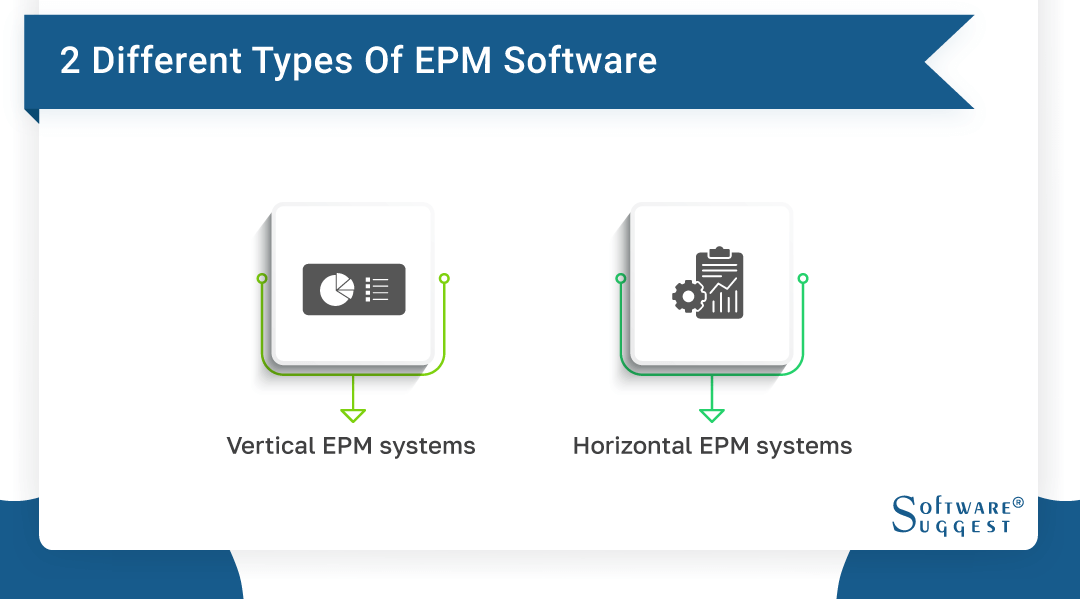
-
Vertical EPM systems
Vertical EPM systems are designed for specific industries, such as healthcare, retail, or manufacturing. These systems are tailored to meet the unique needs of each industry and often include industry-specific metrics and KPIs.
For example, a healthcare EPM system might include metrics for patient satisfaction, readmission rates, and reimbursement rates, while a manufacturing EPM system might include metrics for production efficiency, inventory management, and supply chain performance.
Vertical EPM systems provide industry-specific best practices and workflows to ensure that organizations can operate at peak efficiency. These systems are often designed to integrate with other industry-specific software applications.
E.g., Electronic Health Records (EHRs) software in healthcare or Enterprise Resource Planning (ERP) systems in manufacturing. The advantage of using vertical EPM systems is that they offer a high degree of customization and are tailored to meet the specific needs of each industry.
-
Horizontal EPM systems
Conversely, horizontal EPM systems are formulated to cater to all kinds of establishments, irrespective of their field. These performance management tools offer a wide range of functionality which includes forecasting, financial planning, analysis, budgeting, and reporting. Horizontal EPM systems are often more flexible than vertical systems, but they may not provide the same level of industry-specific functionality.
Horizontal EPM systems are intended to be adaptable to cater to the specific requirements of every organization. They typically offer a variety of pre-made processes and templates. Companies can use these templates to enhance their required financial planning and analysis procedures.
These systems are frequently made to work together with other software programs, such as CRM or ERP systems, for customer relationship management. The benefit of employing horizontal EPM systems is that, regardless of industry, they provide a wide variety of functionality. It can then be personalized to match the unique demands of each firm.
Key Benefits of Enterprise Performance Management (EPM) Software
Corporate performance management software can gain several perks from EPM technologies that can help them enhance their entire business strategy and financial performance. Some of the main pros of utilizing the top EPM software are as follows.
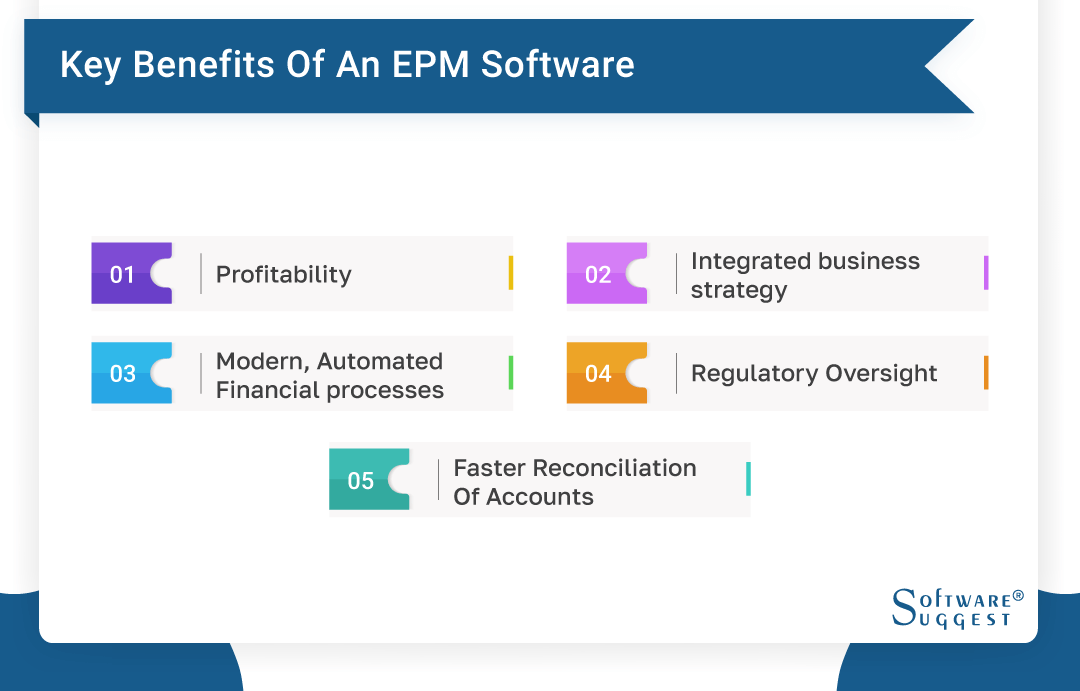
-
Profitability
To effectively forecast future profitability across various business cases and scenarios, one must carefully examine current margins. EPM technology can help boost margins, and financial and operational processes, maximize returns, and find fresh chances to improve performance and profitability.
-
Integrated business strategy
Merge information from all operational segments to attain an all-encompassing view of historical, current, and forthcoming accomplishments. Enterprise Performance Management (EPM) furnishes observations grounded on up-to-the-minute data, enabling companies to scrutinize diverse prospects and choose the most beneficial and efficient approach.
-
Modern, automated financial processes
EPM solutions can assist businesses in modernizing and automating their financial procedures, lowering the possibility of errors and boosting productivity. EPM solutions can free up time for financial professionals to concentrate on higher-value activities like analysis and planning by automating processes like data entry and reconciliation.
-
Regulatory oversight
EPM systems' strong financial controls and reporting capabilities can help firms in meeting regulatory requirements. EPM systems can assist firms in avoiding fines and penalties and maintaining their reputation with stakeholders by ensuring accuracy and openness in financial reporting.
-
Faster reconciliation of accounts
With the automation of processes like account reconciliations and intercompany transactions, business performance management systems can assist firms in hastening the close financial process. EPM systems can help firms in speeding up the closing of their books and increase the accuracy of their financial reporting by lowering the time and effort necessary for these operations.
Essential Features of EPM Tools
EPM tools can also help businesses identify trends and patterns in their financial data, which can be useful in forecasting future performance. There are some common features which is a must in all EPM software. Here are ten common features of EPM software. They are:
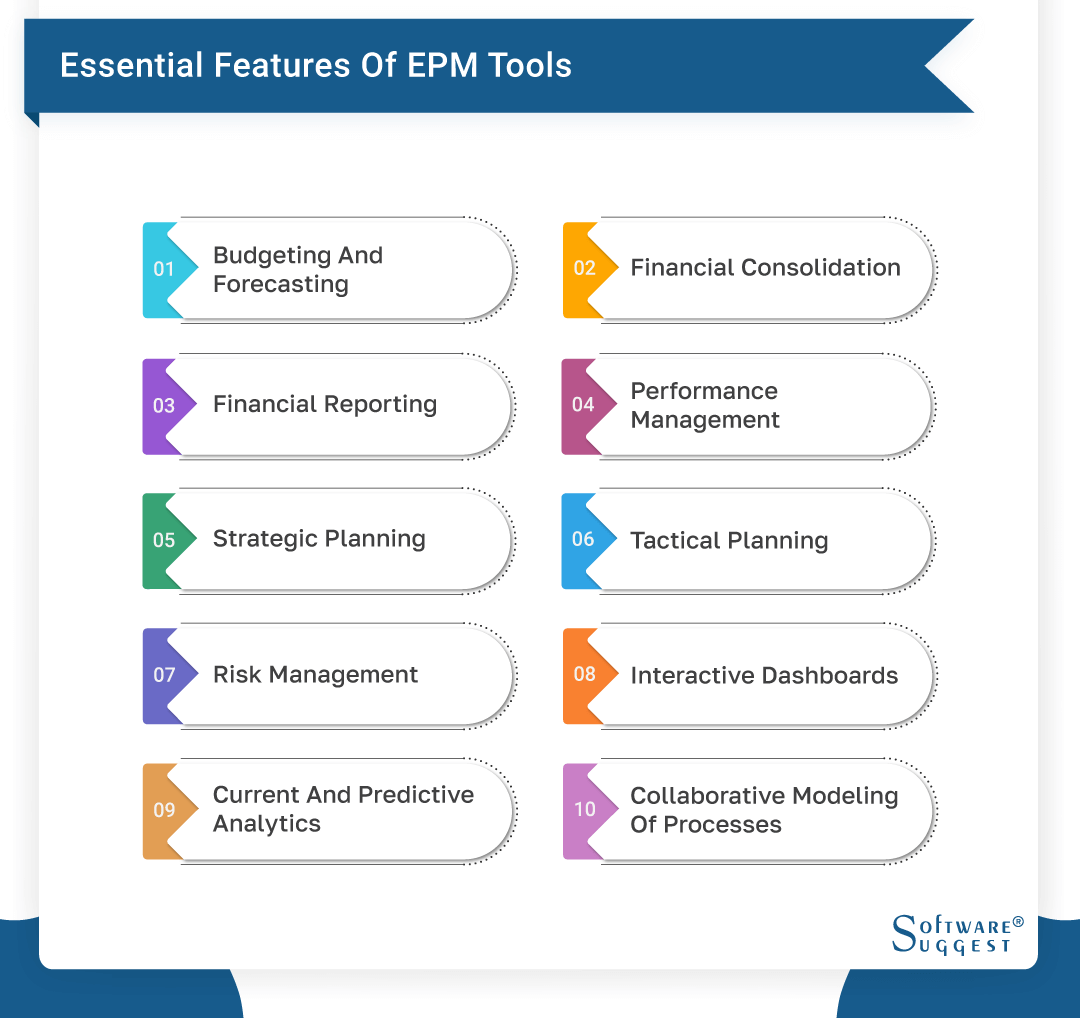
-
Budgeting and forecasting
Enterprise performance management software includes tools for budgeting and forecasting. Firms use the EPM system to gauge and track performance using interactive dashboards and visualizations. Budgeting entails making a strategy for how an organization will use its funds, whereas forecasting entails making financial and operational planning based on historical data. EPM software can assist with budgeting and forecasting by facilitating a quicker, simpler, and more accurate approach.
-
Financial consolidation
The financial consolidation function of EPM tools is another crucial component. Numerous companies have branches, divisions, or subsidiaries, each of which may keep separate financial records. Businesses may integrate this financial data into a single, unified perspective with the aid of the EPM system. As a result, managing financial data is made simpler, and an accurate picture of overall financial performance is obtained.
-
Financial reporting
Moreover, EPM systems provide strong financial reporting capabilities. These tools enable businesses to create tailored reports that offer insights into important financial parameters, including revenue, expenses, and profits. With the help of this information, one can make more informed decisions regarding budgeting and the allocation of resources. Businesses can also create reports using EPM solutions that adhere to legal specifications like IFRS or GAAP.
-
Performance management
EPM tools will provide in managing and enhancing performance. Firms can discover areas where they may be falling short and make modifications to improve performance by monitoring key performance indicators (KPIs). In order to ensure that everyone in the organization is working toward the same objectives, EPM solutions can help firms connect their performance indicators with their overall strategy.
-
Strategic planning
EPM tools are incredibly beneficial for strategic planning. Businesses can make better decisions about their future course by analyzing financial data and spotting trends. EPM technologies can assist businesses in developing comprehensive growth and expansion plans and tracking their results against these objectives. For staying competitive and finding long-term success, this may be crucial.
-
Tactical planning
The usage of EPM tools is also possible for tactical planning. Tactical planning is focused on more recent aims and objectives, while strategic planning emphasizes long-term objectives. Businesses can develop thorough plans using EPM technologies to attain tactical goals like raising sales or cutting expenditures. To keep the company on course, these plans can be modified and updated as necessary.
-
Risk management
EPM tools also perform significant functions in risk management. Businesses can spot potential risk exposure points, such as changes in the regulatory environment or fluctuations in exchange rates, by monitoring important financial KPIs. EPM technologies can assist companies in developing backup plans to address these risks, minimizing the possible impact on the company.
-
Interactive dashboards
Interactive dashboards that give a real-time view of financial data are frequently seen in EPM solutions. This makes it possible for firms to immediately recognize trends and patterns in their financial performance. It may be quite helpful for decision-making. Moreover, interactive dashboards can be tailored to offer views of specific company sectors, like sales or spending, enabling stakeholders to spot problem areas right away.
-
Current and predictive analytics
Current and forecast analytics capabilities are offered by the best EPM tools. Firms can examine their present financial performance using current analytics, and they can anticipate future performance using predictive analytics by using previous data. By utilizing these tools, firms may allocate resources more intelligently and spot possible dangers before they become significant problems.
-
Collaborative modeling of processes
EPM tools also provide collaborative process modeling. Firms can utilize this to simulate various scenarios. Also, they can determine how they will enhance their financial performance. For instance, a company might utilize collaborative modeling to assess how a new product launch will affect revenue and costs. Businesses can better comprehend the potential effects of various scenarios by involving stakeholders from across the firm.
How To Choose The Right EPM System?
The best enterprise performance management software facilitates the preparation, allocation of funds, prediction, and evaluation of a company's monetary and functional efficiency. These systems give useful information on how well a firm is performing, assisting management in making decisions that promote expansion and profitability.
Choosing the best EPM system can be challenging, given the rising demand for them. This article focuses on the following important elements to offer advice on how to pick the best EPM system.
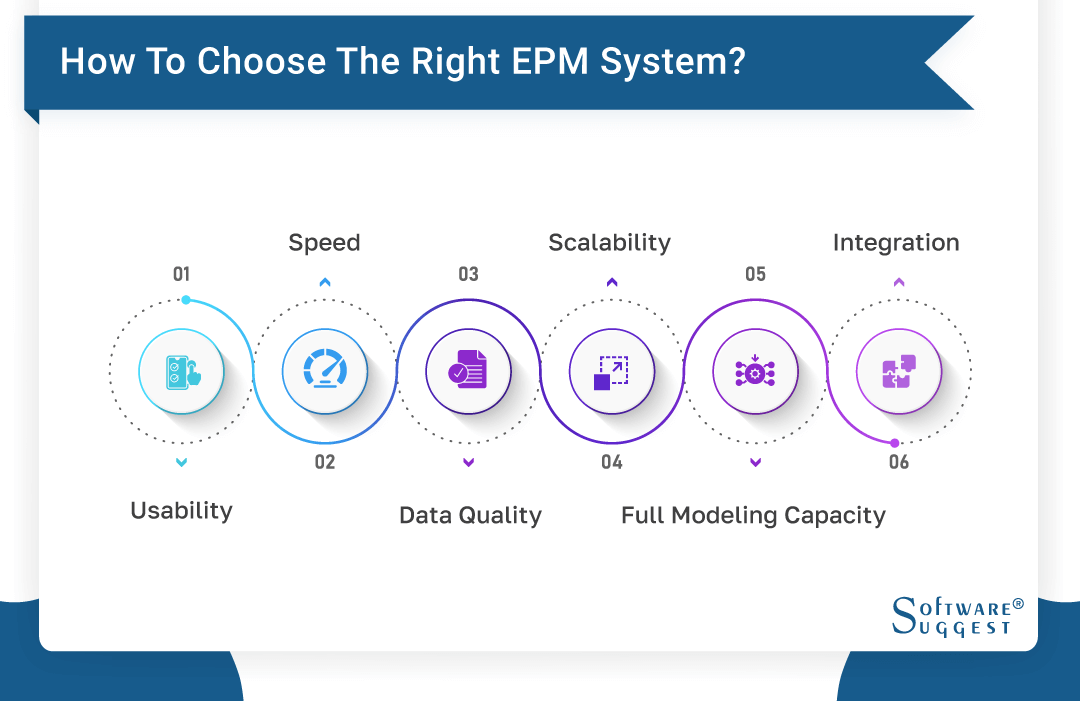
-
Usability
The EPM system's usability measures how user-friendly it is. Users should just need a brief amount of training to begin utilizing the system, making it straightforward to manage. A user-friendly EPM system boosts productivity while saving time and money.
Consider the user interface, the simplicity of data entry, report production, and data visualization when selecting an EPM system. Users should be able to access data and reports with ease, and the system should offer simple dashboards that let users visualize data and see trends fast.
-
Speed
Another crucial factor is the EPM system's speed. Large amounts of data should be handled by the system without encountering noticeable lags. For firms that need real-time financial data to make wise decisions, this is especially crucial. Making decisions can be seriously hampered by a slow or frequently unresponsive EPM system, which can also have a detrimental effect on overall financial performance.
-
Data quality
Data is very vital in any company. But what is more significant is the quality of the data. When you search an performance management solutions in Google, one of the main factors to see is the output quality of data. It should have powerful data governance and management features.
By doing so, you can be sure that data security and compliance are maintained. While choosing an EPM system, take into account its capabilities for data validation, handling complicated data structures, and data interaction with other systems. To monitor data changes and guarantee data integrity, the system also needs to have strong auditing capabilities.
-
Scalability
Scalability is important for EPM software because it allows the system to handle more users or data as the company grows. A scalable EPM system should have a cloud-based architecture that can deliver high performance and meet current and future needs.
Building scalable systems requires experienced engineers who can tune both software design decisions and IT infrastructure. Companies can manage application scalability by creating an EPM Center of Excellence and understanding the growth.
-
Full Modeling Capacity
The system's ability to carry out intricate financial and operational modeling is referred to as having full modeling capacity. Users should be able to build intricate financial models and what-if scenarios using the system's strong analytical capabilities.
Additionally, the system ought to have predictive analytics capabilities that let users predict trends and consequences. While choosing an EPM system, take into account its modeling and analytical capabilities. Also, notice its capacity to carry out difficult computations, develop dynamic models, and offer real-time insights.
-
Integration
When choosing an EPM system, integration is a crucial aspect to take into account. System integration with other systems, such as ERP, CRM, and BI systems, should be seamless. Data integration allows for smooth data transfer between systems, lowering data mistakes and raising data accuracy.
While choosing an EPM system, take into account its integration features, including its capacity to connect to other systems, manage data synchronization, and offer real-time data.
Top 5 Enterprise Performance Management (EPM) Software
|
Name
|
Free Trial
|
Demo
|
Pricing
|
|---|---|---|---|
| 90 Days |
Yes |
Starts at $99 | |
|
7 Days |
Yes | On-Request | |
|
14 Days |
Yes |
Starts at $160 | |
| 30 Days |
Yes |
Starts at $499 | |
|
Yes |
Yes |
Starts at $8 |
So far, you've understood all the essential points for choosing the best EPM tools for your firms. But there are various software that make your buying decision pretty confusing. Here we've brought you the Top 5 EPM software that we researched and found suitable.
One of the top enterprise performance management software is Anaplan. It is a revolutionary approach to thinking about, organizing, and managing your company. To expedite and ensure accurate decisions, Anaplan's distinctive HyperblockTM innovation empowers you to put the present execution into context and anticipate future outcomes.
Anaplan offers interconnected, organization-wide tactics and preparation to progress your business. Headquartered in San Francisco, Anaplan caters to a worldwide clientele of over 2,000 and collaborates with more than 200 associates.
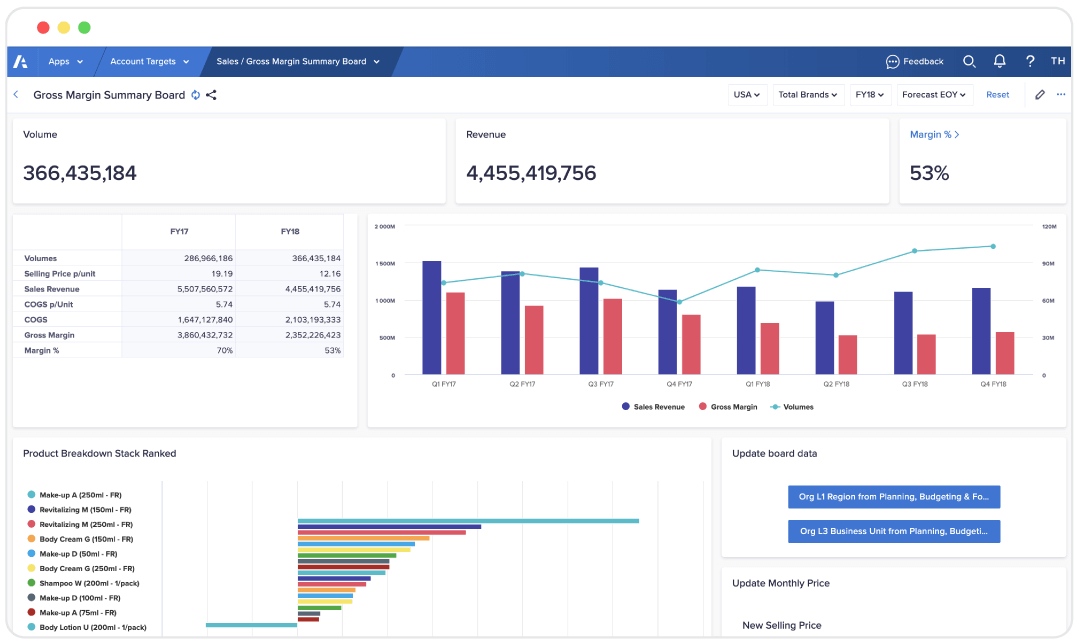
Features
- Pixel-perfect reports
- Drill-down analysis
- Report Versioning
- Pre-built visualization formats (scatter plots, heatmaps, etc.)
- Multiple access permission levels
Pros
- It is very flexible to use
- Data processing is very fast
- Customization offers a lot of variety
- Integrates with various software
Cons
- Slow upload
- The NUX bug should be fixed
Pricing
- Pricing is based on individual requests.
2. Vena
Vena is a Complete Planning tool that enables and motivates business, operational, and financial leaders to rethink how they Plan To Grow their companies. Vena is the solitary CPM platform that exhibits steadfastness for scalability, efficiency, and flexibility at the enterprise level without compromising user-friendliness.
To enable your team to grow in any direction, Vena brings together your workforce, divisions, procedures, and platforms into a unified solution.
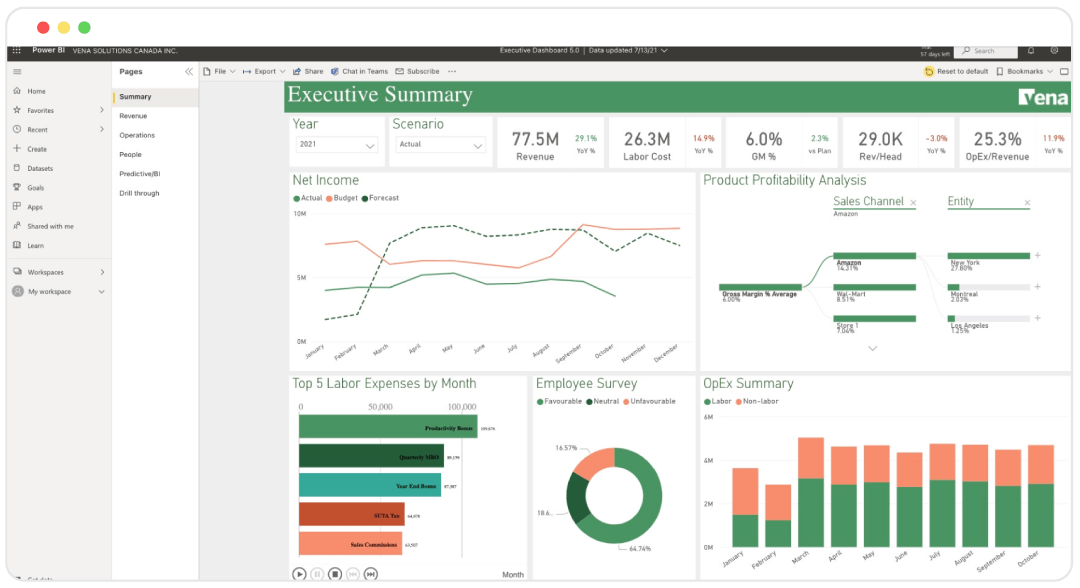
Features
- Financial data consolidation
- Key Performance Indicator setting
- Integration with R or other statistical packages
Pros
- It allows the creation of a multi-cube structure
- System operations might be restricted at times
- Very flexible and dynamic for the various business needs
Cons
- Long learning curve
- System operations might be restricted at times
Pricing
- Pricing is based on individual requests.
3. Jedox
Jedox is the most flexible performance and planning management platform in the world, enabling enterprises to produce plans that perform better than anticipated. Model every scenario, connect data from any source, and streamline cross-organizational plans across all business systems, from FP&A to more extensive integrated business planning.
It creates a culture of decisiveness and confidence so teams can plan for possibilities, react rapidly to changes, and unearth what they didn't realize was possible.
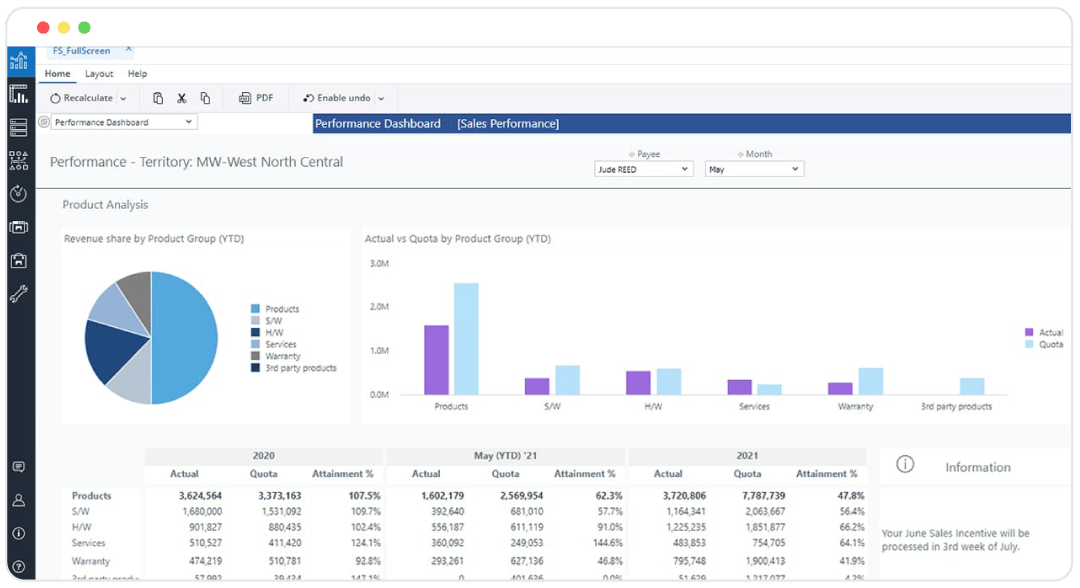
Features
- BI standard reporting
- Location analytics
- Scenario modeling
- Cost and profitability analysis
Pros
- Smooth integration with Excel
- Installing Jedox on any server takes very less time
- The auditing is out-of-the-box
Cons
- CCU ratio licensing is missing
- Sometimes you may feel weak scaling capabilities
Pricing
- Pricing is based on individual requests.
4. Workday Adaptive Planning
In a world that is changing quickly, Workday Adaptive Planning seeks to fuel a new generation of business planning and promote corporate agility. Modeling capabilities are available for businesses of any size through the Workday Adaptive Planning Business Planning Cloud, which also enables user collaboration, insight gathering, and quicker decision-making.

Features
- Financial data consolidation
- XBRL support for regulatory filing
- Journal entries and reports
- Color-coded scorecards
- Benchmarking with external data
Pros
- Easy forecasting
- Easy-to-use layout
- UI is comfortable
Cons
- Little difficult to find smaller details
- Not many great practicing tools for newer users
Pricing
- Pricing is based on individual requests.
5. OneStream XF
OneStream XF is a business performance management program that attempts to streamline the procedures connected to financial planning, reporting, consolidation, analysis, and data quality. Accessible both on-premises and in the cloud, this budgeting solution is the appropriate selection for organizations and can be incorporated into all areas. Firms can use it on a per-module basis.
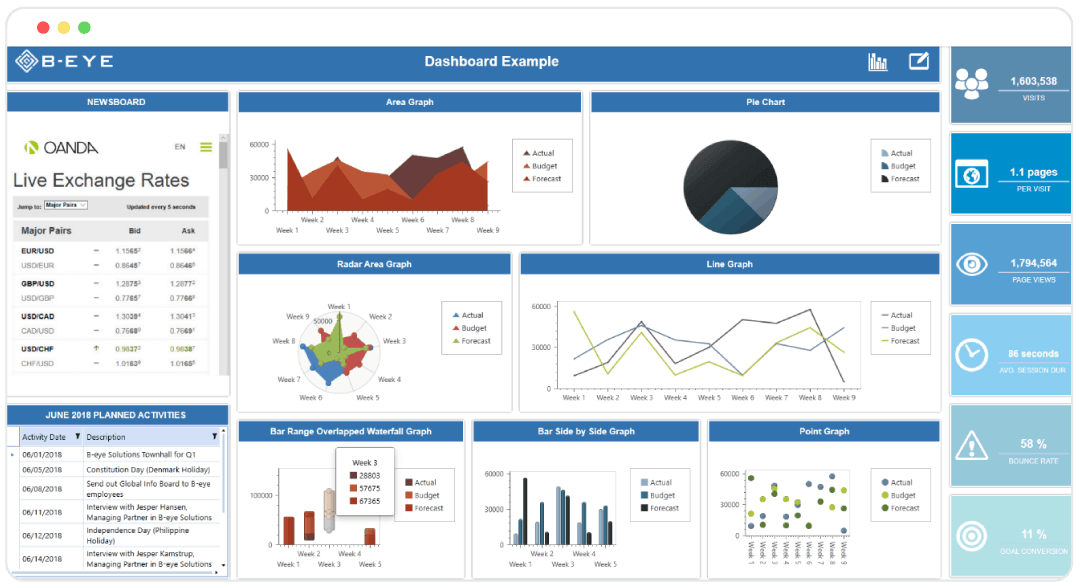
Features
- Data Import/Export
- Financial Reporting
- Forecasting
- Data Visualization
- Drag & Drop
- Financial Analysis
- Financial Management
- Income & Balance Sheet
Pros
- Data can be exported from the system using third-party tools
- Appropriate controls and audit trails
- User-friendly
- Manages metadata on the go
Cons
-
The dashboard learning curve is difficult
Pricing
- Pricing is based on individual requests.
Common Challenges In EPM Software
Enterprise performance management software is created to assist firms in streamlining their financial management procedures and assisting them in making better decisions. EPM software is not without its difficulties, though. Here, we'll look at 4 typical issues companies have with business processes software and how to fix them.
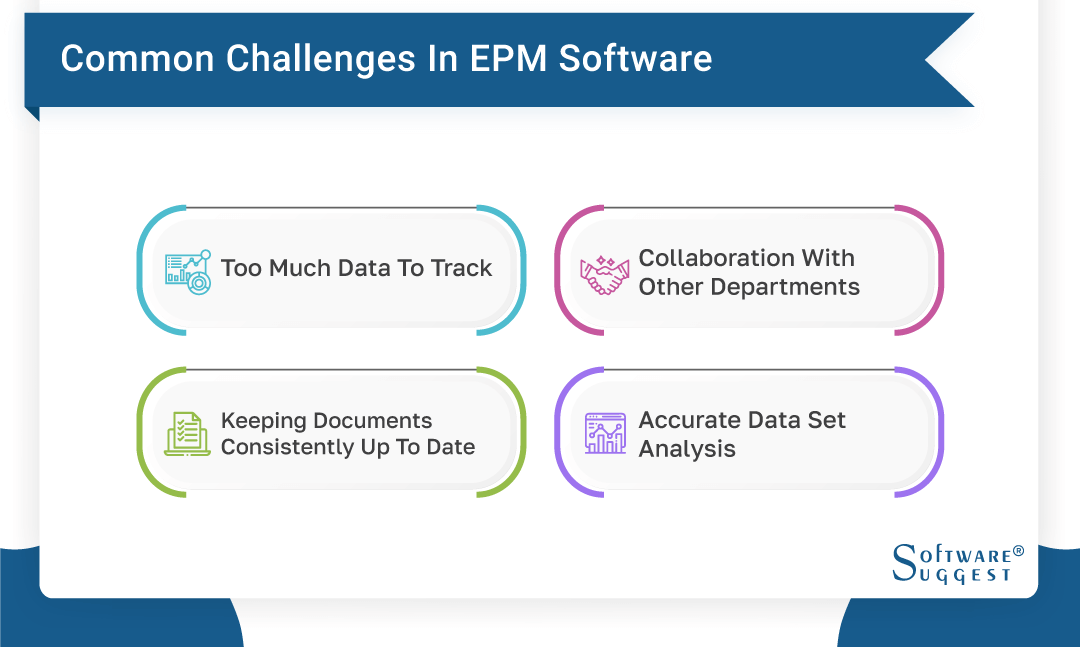
-
Too much data to track
The huge amount of data that needs to be tracked presents one of the main difficulties when utilizing EPM software. Accounting software, ERP systems, and customer relationship management (CRM) systems are just a few of the many sources of financial data. Extracting useful insights might be challenging due to the time-consuming and intimidating nature of managing all of this data.
Businesses can think about implementing EPM software with strong data management capabilities to address this issue. The capacity to combine data from several sources and present a consistent perspective of financial performance is part of this. Businesses can also benefit from EPM software with extensive data analysis capabilities by seeing patterns and trends in financial data, which makes it simpler to derive insightful conclusions.
-
Collaboration with other departments
Working with other departments can be difficult while utilizing EPM software. Various corporate divisions, including finance, accounting, and operations, frequently communicate financial data. It is done to guarantee that all individuals are striving for identical objectives that necessitate collaboration and correspondence among different units.
Firms should invest in EPM software with integrated collaboration features to address this issue. This includes the capacity to construct dashboards that are accessible to all stakeholders, disseminate financial data between departments, and give real-time updates to stakeholders as necessary. Companies can develop reports that can be shared across departments by using EPM software with strong reporting features, ensuring that everyone has access to the same data.
-
Keeping documents consistently up to date
Using EPM software frequently presents the difficulty of maintaining constantly updated documentation. Given how frequently financial data changes, it can be challenging to make sure that all papers and reports are timely updated. Poor decision-making and inaccurate financial data can result from this.
Firms have to invest in EPM software with automated data management features to deal with this challenge. It includes the ability to automatically and instantly update financial data. Also, ensuring that all documents and reports depict the latest information. EPM software with integrated workflows can also help streamline document preparation, ensuring that all stakeholders have access to the same data.
-
Accurate data set analysis
The correct analysis of data sets is another issue that frequently arises while utilizing EPM software. When working with huge data sets, financial data can be extremely complicated and challenging to evaluate. This can make it difficult to draw useful conclusions from financial data.
Afford to invest in EPM software with advanced data analysis capabilities to address this issue. The ability to create personalized reports and dashboards, spot trends and patterns in financial data, and carry out sophisticated statistical analysis as necessary are all included in this. Businesses can also benefit from the use of EPM software with machine learning capabilities to spot financial data correlations and trends that might not be immediately apparent.
Latest Trends In Enterprise Performance Management (EPM) System
The EPM sector is a dynamic industry that is continually changing and adapting to the demands of contemporary enterprises. Here, we will look at a few recent developments in EPM systems that companies should be aware of.
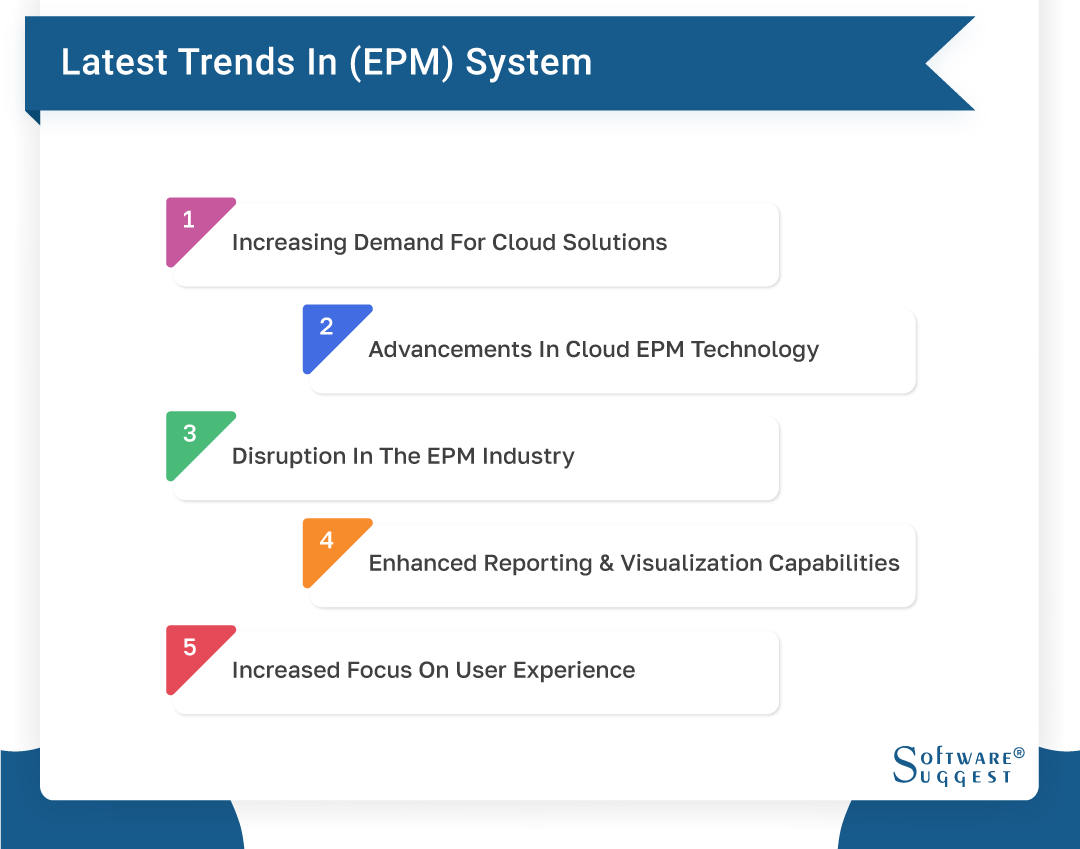
-
Increasing demand for cloud solutions
The growing requirement for cloud-based solutions is one of the main developments in EPM systems. Compared to conventional on-premise solutions, cloud EPM systems have various perks, such as cheaper costs, more scalability, and increased data protection. The need for cloud EPM solutions is likely to grow as companies continue to transfer their activities to the cloud.
-
Advancements in cloud EPM technology
The growth of cloud-based solutions is also being fueled by developments in cloud EPM technologies. Modern cloud EPM systems have capabilities that streamline financial management procedures and enhance overall performance. These developments include tools for real-time data visualization, predictive analytics, and machine learning capabilities.
-
Disruption in the EPM industry
The EPM sector is likewise seeing turmoil as new competitors challenge long-standing vendors. As a result, new and inventive EPM solutions are being developed as a result of competition and creativity. Businesses should be aware of the new participants in the industry and the solutions they provide as they assess their EPM needs.
-
Enhanced reporting and visualization capabilities
In terms of reporting and visualization features, EPM systems are also improving. Businesses may better understand their financial data and make better decisions with the help of cutting-edge data visualization technologies. Businesses can create customized reports and dashboards catered to their unique needs using EPM systems with expanded reporting and visualization capabilities.
-
Increased focus on user experience
Finally, EPM vendors are putting a greater emphasis on user experience by creating interfaces that are clear and simple to use. This is crucial for companies whose EPM systems are used to manage financial data. The implementation of EPM systems can be significantly hampered by their complexity and need for considerable training, which results in low utilization and subpar performance.
Conclusion
In conclusion, choosing the right EPM software is vital for establishments to achieve their financial goals. It offers a comprehensive EPM solution that enables financial planning and analysis teams to anticipate performance gaps. Also, it collaborates with the business and executes timely planning, analysis, and reporting.





















